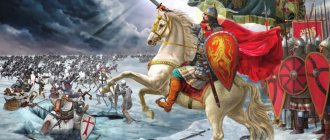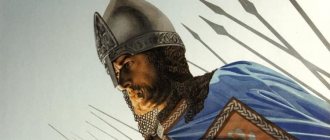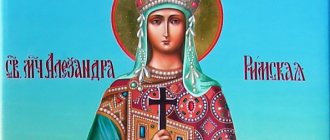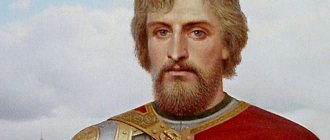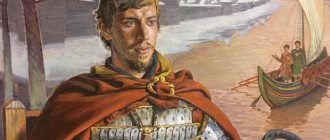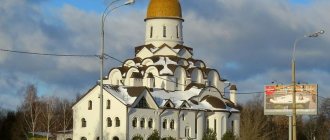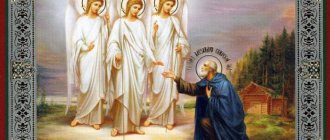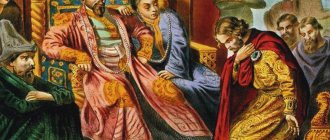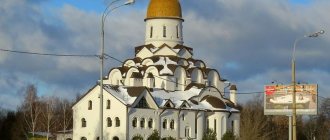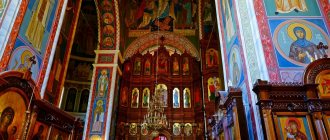Alexander Nevsky is an Orthodox saint, a great Russian prince, who is the embodiment of courage, wisdom and justice. It is generally accepted that this particular person personifies Russia and is one of the most worthy representatives of his country. During his life, the prince tirelessly followed all the canons of the Christian faith, kept the commandments, thanks to which he went down in history as a pious ruler. On icons he is often depicted in armor, emphasizing the noble status of the defender of his homeland.
The life and spiritual path of the holy prince
Alexander Nevsky was born in Pereyaslavl-Zalessky in May 1220. His father was the Pereyaslavl prince Yaroslav Vsevolodovich, his mother was the Ryazan princess Feodosia Igorevna.
In 1228, the still young Alexander was sent to Novgorod along with his older brother. From 1236 he began to independently defend Russian lands from invaders. In July 1240, a memorable battle took place, during which the young prince won a complete victory over the Swedes on the Neva. It was after these historical events that they began to call him Alexander Nevsky.
In addition to the famous battle on the Neva River, the prince became famous for other exploits:
- victory over the Livonian Order on Lake Peipus (Battle of the Ice);
- the defeat of the Lithuanian troops who wanted to capture the Russian cities of Torzhok and Bezhetsk;
- liberation of the Novgorod and Pskov lands from the German invasion.
Alexander Nevsky was officially canonized in 1549. The prince is known for many deeds aimed at the spiritual development of his people. He sought to develop the Orthodox faith, prevented the planting of the Catholic religion on Russian lands, and fought against the heretical movement. Alexander contributed to the spread of Orthodoxy among the northern peoples of Rus', assisted in the construction of new churches, and bestowed rich gifts and land plots on monasteries and churches.
The outstanding ruler and righteous man died in November 1263. They began to venerate the holy noble prince immediately after his death. His body was buried in the city of Vladimir, on the territory of the Nativity Monastery.
Half a century later, at the behest of Peter the Great, the relics of the Grand Duke were transferred to the Alexander Nevsky Monastery in St. Petersburg. To store the princely remains, a rich silver tomb was installed, which was decorated with an ancient icon standing on top. Today these sacred attributes reside within the walls of the State Hermitage.
The life of a faithful warrior
The defender and collector of Russian lands was born in 1220 in the family of the youngest son of Prince Vsevolod the Big Nest. At the age of six, the boy was ordained as a warrior by Bishop Simon of Suzdal. Throughout his short life, the prince defended the Fatherland.
Icon of Alexander Nevsky on horseback
Among his most significant achievements are the following:
- in a number of Russian lands taxes in favor of the Mongols were abolished;
- Russian principalities were not raided;
- most of the principalities were united under the hand of a single ruler - the process of unification of Rus' began;
- the Latinization of the Eastern Slavs was prevented;
- strengthening and ensuring peace on the western borders of the emerging Russian state.
The main merit of the holy noble prince Alexander Nevsky is the preservation of the Orthodox faith and its preaching among other nations.
Interesting! During his trips to the Horde, Alexander Nevsky not only enlisted the support of the Tatar khans, but also had conversations with them about Orthodoxy. Thanks to this, an Orthodox community appeared in Sarai Batu, and some representatives of the Khan dynasty accepted the Orthodox faith.
Description of the icon of Alexander Nevsky
Until the 18th century, the iconography of the saint was dominated by images in monastic vestments. In 1724, the Holy Synod issued a decree, which ordered that Alexander Nevsky be painted in grand ducal robes (photos of paintings):
As a rule, on icons the prince looks like a young man with a strong physique and a handsome, noble face. Most often he is depicted in military garb. In some images the Russian ruler appears in full growth, in others there is a half-length image.
The high title of Alexander Nevsky is indicated by the presence of a princely mantle worn over armor, as well as a rich headdress decorated with a cross and precious stones. In his left hand, the noble prince holds a banner with the face of the Savior, and presses his right hand to his chest (this gesture is a symbol of fidelity to Orthodoxy). In some icons the saint holds a cross and a sword. Sometimes he appears riding a horse.
Behind the back of the Grand Duke you can see the city wall, behind which there are houses and church domes or a river bank and ships. The saint is often depicted standing in a field where a battle with opponents of the Russian people is taking place. An angel with a crown in his hands hovers above the battlefield.
There are icons on which Alexander Nevsky is depicted already in adulthood and in the schema (it is known that before his death the prince became very ill and took monastic vows under the name Alexy). In such images the saint is often turned towards Christ seated on the clouds. The Savior holds an open book in his left hand, and with his right hand blesses the righteous.
Iconography
The first icons depicting St. Alexander Nevsky appeared after his canonization. Until the beginning of the 18th century, the “monastic” iconographic image prevailed. The noble prince, who took monastic vows before his death, was depicted in traditional monastic vestments. Such icons are located in the Hagia Sophia Cathedral in Novgorod and the Annunciation Church in the Moscow Kremlin.
At the beginning of the 18th century (1724), the Holy Synod ordered that the saint be depicted in princely attire. Under the princely mantle one can see military armor, and in his left hand he holds a sword - a symbol of military exploits in order to protect the Orthodox faith. In the right hand of the prince-preacher there may be an image of Jesus Christ, a cross or a spiritual letter. They symbolize the commitment of the blessed Alexander Nevsky to Orthodoxy and his merits in spreading it. On some icons the saint's right hand is pressed to his heart.
Icon of Alexander Nevsky
In the 20th century, icon painters use two iconographic versions. In the 70s, an icon was painted that combines the characteristics of both the “monastic” and “princely” types of images of the holy wonderworker, blessed Alexander Nevsky.
The meaning of the image of the holy prince
The icon of Prince Alexander Nevsky is an important Christian shrine that carries a deep meaning and is of great importance for the Russian Orthodox people. The image immortalized an outstanding defender of his native land, a wise ruler standing guard over the Russian state, a saint of God. The image is intended to remind Christians of eternal values, such as patriotism, love, mercy towards others, deep faith in the Lord. Standing in front of the icon of Alexander Nevsky, every believer remembers that the faithful warrior devoted his entire life to protecting and strengthening Orthodoxy and fighting enemy raids.
The image of the holy prince was prayed to at different times, including the Soviet era, known for its negative attitude towards religion. There is information that residents of besieged Leningrad turned to him as the last hope for help in a difficult situation.
Life of a Saint
During his short life (only 42 years), Alexander had to work hard to protect the Russian principalities from expansion from the Catholic West: he defeated the Swedish army on the Neva, and then defeated the German Order of the Sword during the Battle of the Ice.
Sometimes Alexander is blamed for not giving the same rebuff to the Mongol Khanate, but this precisely testifies to his statesmanship and foresight.
Firstly, the Mongol forces were many times superior to the Russian forces, so one could not count on a military response; secondly, Rus' found itself between two powerful enemies, pressing from both the West and the East, and history confronted Alexander with a difficult choice of an ally.
The choice in favor of the Mongol Khanate was largely due to the fact that it did not interfere in religious life and did not impose its beliefs, unlike the Western invaders. Thus, he contributed to the preservation of the purity of the Orthodox faith. In addition, Alexander managed to negotiate the abolition of taxes in favor of the Mongols in a number of areas.
When the wise and beloved ruler of the people died, he began to be revered as the defender and patron of the entire Russian people, who had not lost a single battle and defended the Orthodox faith.
In 1547 he was canonized by the Russian Orthodox Church.
Where is the icon of Alexander Nevsky located today?
You can venerate the image of the Grand Duke in many Russian and other churches. Icons of the righteous are located:
- in Moscow, in St. Basil's Cathedral. This picture depicts not only events from the life of Alexander Nevsky, but also episodes of the Crimean Battle, the victorious battle of the Russian ruler with Khan Giray;
- in St. Petersburg, in the Church of the Savior on Spilled Blood. An image is kept here in which the outstanding warrior and ruler appears as a humble monk;
- In Nizhniy Novgorod. The icon, located in the local cathedral, is recognized as miraculous. During its existence, it has become a real salvation for many people;
- in Kyiv, in the Vladimir Cathedral. In this painting there is an image of the great Russian prince, who looks like an epic hero.
In Russia, a large number of churches are dedicated to the holy blessed Alexander Nevsky. Also, in memory of him, many monuments were erected, located in St. Petersburg, Novgorod, Pskov, Kursk, and Vladimir.
Churches built in honor of the saint can be found throughout Europe - in Warsaw, Paris, Tallinn, Belgrade. In Bulgaria there is the famous Alexander Nevsky Cathedral, erected as a sign of gratitude to the Russian people for their liberation from the Ottoman yoke during the Russian-Turkish War. In this temple there is a sacred image in which Alexander Nevsky holds in his hands a scroll with the inscription: “Fear the Lord and fulfill the covenants.” In addition to the prince, the icon contains images of John and Abraham of Rostov.
On the history of the veneration of the holy noble prince Alexander Nevsky
[1] Karamzin N.M.
History of Russian Goverment. T. 4. Ch. 1 // https://www.magister.msk.ru/library/history/karamzin/kar04_01.htm
[2] Soloviev. CM.
History of Russia from ancient times. T. 3. Ch. 3 // https://www.magister.msk.ru/library/history/solov/solv03p3.htm.
[3]Surmina I.O.
Alexander Nevsky in Russian pre-revolutionary historiography // https://www.sgu.ru/files/nodes/9832/02.pdf.
[4] Kuchkin V.A.
On the biography of Alexander Nevsky // The most ancient states on the territory of the USSR: Materials and research.
M., 1985; Nasonov A.N.
Mongols and Rus': History of Tatar politics in Rus'.
M.; L., 1940; Battle of the Ice 1242: Sat. articles. M.; L., 1966; Pashuto V.T.
The heroic struggle of the Russian people for independence (XIII century).
M., 1956; Shaskolsky I P.
The struggle of Russia against crusader aggression on the shores of the Baltic in the 12th–13th centuries.
L., 1978; Andreev A.R.
Prince Dovmont of Pskov.
Documentary biography. M., 1997; Begunov Yu.K.
Alexander Nevskiy. The life and deeds of the holy and blessed Grand Duke. M., 2003; Prince Alexander Nevsky: Scientific and practical materials. conf. 1989 and 1994 St. Petersburg, 1995; Prince Alexander Nevsky and his era. St. Petersburg, 1995; Alexander Nevsky and the history of Russia: Scientific and practical materials. conf. 1995 Novgorod, 1996; and others.
[5] See: Danilevsky I.N.
Battle on the Ice: change of image // https://www.strana-oz.ru/?numid=20&article=934;
Smirnov S.B.
The end of Russian democracy // https://zhurnal.lib.ru/s/smirnow_s_b/nowgorod.shtml.
Among the most recent works of a critical nature, one can highlight the book by A.N. Nesterenko “Alexander Nevsky. Who won the Battle of the Ice" (M., 2006). “What will be the objective assessment of the activities of Alexander Yaroslavich? The real Alexander was an accomplice of the Tatars and did not repel any threat from the West. He was not a defender of the Russian land and an outstanding commander,” this is the conclusion made by A.N. Nesterenko (P. 270). Among foreign critics, one can highlight the works of Oxford University professor J. Fennell, “The Crisis of Medieval Rus': 1200–1304.” (Ed. A.L. Khoroshkevich and A.I. Pliguzov. M., 1989. pp. 142–145, 162–163.) and an article by the director of the Institute of Eastern and South-Eastern History at the University of Munich. Ludwig Maximilian Edgar Hoesch ( E. Hoesch.
Eastern policy of the German Order in the 13th century // Prince Alexander Nevsky and his era. Research and materials. St. Petersburg, 1995. pp. 65–74).
[6] Reginskaya N.V., Tsvetkov S.V.
The noble prince of Orthodox Rus' is the holy warrior Alexander Nevsky. St. Petersburg, 2010. pp. 179–182.
[7] Surmina I.O.
Alexander Nevsky in Russian pre-revolutionary historiography // https://www.sgu.ru/files/nodes/9832/02.pdf.
[8] Fritjon Benjamin Schenk.
Russian hero or myth? // Homeland. 2003. No. 12. pp. 91–93.
[9] Begunov Yu.K.
Life of Alexander Nevsky in Russian literature of the 13th–18th centuries. // Prince Alexander Nevsky and his era. pp. 163–164.
[10] Fritjon Benjamin Schenk.
Russian hero or myth? P. 92.
[11] Macarius (Bulgakov),
Metropolitan History of the Russian Church. T. 3 // https://www.magister.msk.ru/library/history/makary/mak3104.htm#number2.
[12] Alexander Yaroslavich entered our historical memory with the nickname Nevsky. In “The Tale of the Life and Courage of the Blessed and Grand Duke Alexander,” compiled in Vladimir between 1263 and 1280, the Novgorod prince is never called “Nevsky.” In the Novgorod chronicles we will meet him mentioned as Brave. Only at the end of the 15th century, according to the observation of V.V. Tyurin, Alexander Yaroslavich was first mentioned in all-Russian chronicles as Nevsky ( Tyurin V.V.
Ancient Novgorod in Russian literature of the 20th century: Reality and myths // The past of Novgorod and the Novgorod land: Scientific materials.
conf. November 11–13, 1998 Novgorod, 1998. P. 197). The matter is complicated by the fact that with the same nickname in the story “On the Conception of the Reigning City of Moscow” from the “Chronograph of Dorotheus of Monemvasia”, preserved in the list of the late 17th century. (collection of the State Historical Museum) the sons of Alexander are mentioned, who under no circumstances could take part in this battle: “In the summer of October 6889, on the 29th day in Volodymyr, the city of Prince Vladimer, Prince Andrei Alexandrovich Nevsky ruled, and in the city Suzdal was ruled by Prince Danil Alexandrovich Nevsky" ( Tikhomirov M.N.
Ancient Moscow: XII-XV centuries //
Tikhomirov M.N.
Ancient Moscow: XII-XV centuries; Medieval Russia on international routes: XIV-XV centuries. M, 1992 . P. 177).
Sometimes this is explained by the fact that the nickname Nevsky was not associated with Alexander’s victory over the Swedes, but was possessive, that is, it pointed to the princely possessions on the banks of the Neva ( Danilevsky I.N.
Russian lands through the eyes of contemporaries and descendants (XII-XIII centuries) : Course of lectures. M., 2001. pp. 191–192).
Vladimir Rogoza’s attempt to explain why Alexander was named Nevsky and not Chudsky still looks untenable. He writes that “the decisive role in the battle on the ice of Lake Peipus was played by the warriors of brother Andrei, who were sent to Alexander by their father, Yaroslav Vsevolodovich. And this was well known in Rus', while the Battle of the Neva went unnoticed. The compilers of the Life did not give the holy prince an honorary prefix for the battle, in which it was clearly not his warriors who made the main contribution to the victory" ( Rogoza V.
Why did Prince Alexander Yaroslavich become Nevsky, and not Chudsky? //https://digestweb.ru/ 20196-pochemu-knyaz-aleksandr-yaroslavich-stal-nevskim-a-ne-chudskim-chast-2.html).
Let us note that initially, from the moment of his arrival in Novgorod, Alexander acted decisively and independently. Without waiting for his brother, he, together with the Novgorodians, liberated Koporye, which was also known in Rus'. But to liberate Pskov and a large-scale war with the order, it was necessary to gather large forces. Brother Andrei comes to Alexander's aid. However, in the campaign itself in Livonia and in the battle on the ice of Lake Peipsi, Alexander Yaroslavich was the sole commander-in-chief. Therefore, despite the fact that the “Nizovsky regiments” really played a big role in the battle, due respect should still be given to Alexander Yaroslavich as the commander-in-chief of the Novgorod and Vladimir-Suzdal regiments (see: Shcherbakov A., Dzys I.
Battle of the Ice. M., 2001. S. 47–49, 74–77).
Also in the chronicles and the Rhymed Chronicle, significant attention is paid to Alexander as the leader of the Russian army ( Matuzova V.I., Nazarova E.L.
Crusaders and Russia. The end of the 12th century - 1270. Texts, translation, commentary. M., 2002. pp. 232–234, 321–323).
[13] Sokolov R.A.
Alexander Nevsky: panorama of the latest opinions //
Klepinin N.A.
Holy Blessed Prince Alexander Nevsky. St. Petersburg, 2004. P. 275. For local canonization, it was necessary to have evidence of the incorruption of the relics, notification of miracles from the relics, a description of the righteous life of the saint of God, and the consent of local church authorities to canonization. Life served all these purposes. It can be said that with the acceptance of the life, the foundations were laid for the veneration of Alexander Nevsky, his conciliar acceptance into the bosom of the saints of the Russian Orthodox Church.
[14] Surmina I.O.
Alexander Nevsky in Russian pre-revolutionary historiography.
[15] This is what is conveyed in the ancient life of the blessed prince about the miraculous help he provided to his relative, Grand Duke Dimitri Ivanovich. In the monastery of the Most Holy Theotokos in Vladimir, where the relics of the blessed prince rested, one God-fearing monk, who led a pious ascetic life, at night in the church vestibule with tears prayed to the Lord for the deliverance of Rus' from the hordes of the Tatar leader Mamai. In his prayer he called upon the blessed Prince Alexander to help Grand Duke Demetrius. And during his prayer, he saw that in front of the tomb of the blessed prince the candles lit up by themselves, then two splendid elders came out of the altar and, approaching the tomb of the saint, said: “Get up, hasten to the aid of your kinsman, the noble prince Dimitri Ioannovich.” And the holy prince Alexander immediately stood up and became invisible. The monk was struck by this miracle and remained silent, and only after it was learned that the glorious Don victory had taken place at that time, did he report his vision to Saint Vladimir. By order of the Bishop, the relics of the blessed prince were then examined, which were found incorrupt ( Gusakova V.O.
About the life of the Holy Blessed Grand Duke Alexander Nevsky
// https://www.iconworld.ru/products/124).
[16] Russian holy warriors. Lives. Spassky Cathedral - "Power". M., 2000. P. 247.
[17] According to Metropolitan John (Snychev), “to save Russia, Prince Alexander had to simultaneously show the valor of a warrior and the humility of a monk” ( John (Snychev)
, metropolitan
In memory of the Holy Blessed Grand Duke Alexander Nevsky // Russian Knot. Articles, conversations, appeals. St. Petersburg, 2006. P. 338). It can be said that the iconography of Alexander Nevsky, which developed in two versions, reflected the essence of this feat of the prince. In the first, the holy prince is presented in princely attire, with weapons; in the second - in monastic vestments, like the wonderworker and monk Alexy, in memory of the fact that before his death, Prince Alexander accepted monasticism with this name. Note that until the 18th century. the second iconographic version prevailed (see: Begunov Yu.K. Iconography of the Holy Blessed Prince Alexander Nevsky // Prince Alexander Nevsky and his era. pp. 172–175).
In addition, a large number of icons of the noble prince, painted from the 14th to the 21st centuries, makes it possible to create a retrospective iconography of the iconographic image in historical time: the 14th–16th centuries. - Saint Alexander Nevsky - a warrior in a group of fighting Novgorodians;
XVI–XVIII centuries - as a schema-monk and holy warrior;
XVI–XIX centuries - a warrior in the group of saints standing before the Savior or the Mother of God;
XVIII century – Alexander Nevsky – a warrior on foot or on horseback in knightly garb;
XIX century - in the clothes of a Russian prince;
90s XIX century – 10s XX century – praying;
XIX–XX centuries – Alexander Nevsky – all existing types are present in icon painting ( Reginskaya N.V., Tsvetkov S.V.
The noble prince of Orthodox Rus' is the holy warrior Alexander Nevsky. P. 254).
[18] Shaskolsky I. P.
The struggle of Rus' against crusader aggression on the shores of the Baltic in the 12th–13th centuries.
L., 1978. P. 143; Uzhankov Alexander.
“Through a glass darkly” // https://gask.countries.ru/?pid=183.
[19] In 1552, setting out on a campaign to conquer the Kazan kingdom, Tsar John Vasilyevich prayed in Vladimir before the reliquary of the relics of the blessed Prince Alexander, calling on him for help. As if as a pledge of his help, the noble prince performed the following miracle. His boyars prayed with the tsar, including the future descriptor of the miracles of the noble prince. When he, together with others, venerated the relics of the saint, he placed three fingers of his sick hand into the well (hole) of the reliquary. It seemed to him that he had soaked them in some kind of fragrant mastic, and when he took out his hand, not a trace remained of the previous illness. All those present at this miraculous healing reverently glorified the blessed Prince Alexander, who had been granted the gift of healing by the Lord, and with the hope of his help they set off on their further journey (Russian holy warriors. Lives. Spassky Cathedral - “Power”. pp. 247-249).
[20] The first church in honor of St. Alexander Nevsky was built in 1630 by Metropolitan Philaret in the Moscow Kremlin above the Tainitsky Gate ( Reginskaya N.V., Tsvetkov S.V.
The noble prince of Orthodox Rus' is the holy warrior Alexander Nevsky. P. 180).
[21] Fritjon Benjamin Schenk.
Russian hero or myth? P. 92.
[22] Ibid. In fact, the battle of 1240 took place almost 20 km from the site of the founding of the monastery, which in 1797 was transformed into a monastery.
[23] On June 15, 1724, the Holy Synod decided: from now on, Alexander Nevsky “should not be depicted as a monastic person,” but only “in the robes of a grand duke.” Since then, a new iconographic type of Saint Alexander Nevsky has spread and become dominant in Russian icon painting: in princely clothes or in an ermine robe, in armor, with the ribbon of his order over his shoulder, in a royal crown or in a hat made of ermine fur with a cross, with a halo above head, riding a horse and with a sword in his left hand, often against the backdrop of the Neva, the Peter and Paul Fortress, the chambers of St. Petersburg and the plan of the Holy Trinity Alexander Nevsky Monastery. On May 21, 1725, Catherine I established the Order of St. Alexander Nevsky; a cross is attached to the ribbon, and in the middle of it is an image of the holy prince in a red robe and a blue caftan, on a white horse. This was a tribute to the new iconographic tradition, connecting the old secular Novgorod-Moscow tradition with the new, knightly and European one ( Begunov Yu.K.
Iconography of the Holy Blessed Prince Alexander Nevsky // Prince Alexander Nevsky and his era.
Research and materials. P. 174). The establishment of a new order named after Alexander Nevsky was conceived by Peter to be awarded exclusively for military merit. Subsequently, the order was renewed in 1942. Currently, the Order of Alexander Nevsky is the only award that existed (with certain changes) in the award systems of the Russian Empire, the Soviet Union and the Russian Federation ( Balyazin V.N., Durov V.A., Kazakevich A. .N.
The most famous awards of Russia. M., 2000. P. 37, 258).
[24] In February 1722, fulfilling the decree of Peter I, Archbishop Theodosius visited the Nativity Monastery in Vladimir, where the relics of Saint Prince Alexander Nevsky were located, and together with the monastery’s Archimandrite Sergius, he examined the relics kept in the silver tomb. The transfer of the relics of the blessed Prince Alexander Nevsky from the Nativity Monastery of Vladimir to the Trinity Monastery of St. Petersburg began on August 11, 1723. After the liturgy and prayer service with the blessing of water, the holy relics of Alexander Nevsky were lifted, carried out to the southern doors of the cathedral and placed in the ark. Vladimir escorted the relics with the ringing of bells until midnight. On August 17, the holy relics were brought to Moscow, on August 23, the relics were in Klin, on the 26th - in Tver, on the 28th - in Torzhok, on the 31st - in Vyshny Volochyok. On September 9, the holy relics were transferred across Lake Ilmen to Novgorod. On September 20, the holy relics were brought to Shlisselburg and placed in a stone church, where they remained until the following July 1724. On July 24, 1724, Peter I ordered Archbishop Theodosius to go “to Shlisselburg to the tomb of the holy noble prince Alexander Nevsky with the relics” and complete them transfer to St. Petersburg until August 30. On the morning of Sunday, August 30, 1724, the capital was notified of the start of the celebration with three shots from the Peter and Paul Fortress. The Neva fleet in full force (even the boat of Peter I was withdrawn) went up the Neva to meet the galley with holy relics. Peter I moved to the galley, where he himself stood at the helm, and the dignitaries who were with him sat at the oars. With a cannon salute and bell ringing, the venerable relics of Saint Prince Alexander Nevsky were met on the banks of the Neva, near the Monastyrka River. From the shore, the holy relics were transferred by the king and dignitaries to the monastery and placed in a new church, which was consecrated on the same day (see: Menaion. August. Part 3. M.: Publishing Council of the Russian Orthodox Church, 2007. P. 268– 269).
[25] The Synod entrusted the preparation of the new service to the “Obereromonk of the fleet, adviser to the Synod, schools and printing houses, protector” Archimandrite Gabriel (Buzhinsky). An associate of Peter I, a famous preacher who wrote, according to the emperor, “clearly and in good calm,” Archimandrite Gabriel composed many words of praise on the victories of Russian weapons, in praise of Emperor Peter and the city he founded on the banks of the Neva. In 1725, in the printing house at the Alexander Nevsky Monastery, the service with thanksgiving for the conclusion of eternal peace between the Russian Empire and Sweden was printed in five editions of 1,200 copies each. Several more editions followed the following year, bringing the total number of copies to 11,900; they were transferred to the Synod for distribution to the dioceses. However, the distribution of the new service soon ceased. In the words of the service about the internal Russian affairs of the Petrovs: “and inwardly, many evil things have befallen us, humility from the all-evil rebels, who have committed much bloodshed. Moved by the heart of Absalomla, which is opposed to everything, not only the deeds of the father are carefully refuted, but also seeking his health” (stichera on the litany, tone 5), - Archimandrite of the Pskov-Pechersk Monastery Markell (Radyshevsky) saw a reproach of the high honor of Tsarevich Alexei Petrovich of blessed memory, martyred by Peter I in the Peter and Paul Fortress in 1717. By decree of Empress Catherine I of September 18, 1727, it was ordered: “The services of the Holy Blessed Grand Duke Alexander, which were sent throughout the Russian Empire to the church, from those churches, collect everything as before... and preserve those services until the decree is intact, from now on the celebration of the Grand Duke Alexander Nevsky will continue to be celebrated according to the monthly Menea.” The service for the transfer of relics and the life, compiled by Archimandrite Gabriel (Buzhinsky) and edited by Peter I himself, became the lot of handwritten tradition until they were included in the book of Lives of Russian Saints in the 60s of the 18th century.
[26] Even in the cities of the western provinces of the Russian Empire, churches were built in honor of the holy prince: in Warsaw, Tallinn, Vilnius, Sveaborg, Tartu, Daugavpils, Riga, many of which are now destroyed ( Reginskaya N.V., Tsvetkov S.V.
The noble prince of Orthodox Rus' is the holy warrior Alexander Nevsky. P. 181).
[27] Dolgov V.
Through a glass darkly // Motherland. 2003. No. 12. P. 86.
[28] In the summer of 1917, in view of the German attack on Petrograd, the Holy Synod instructed Archbishop Benjamin of Petrograd, Bishop Seraphim and Bishop Procopius to open the shrine with the relics of St. Alexander Nevsky and examine the remains in case of their urgent evacuation; from the words of Bishop Seraphim, Sergei Petrovich Kablukov, secretary of the St. Petersburg Religious and Philosophical Society, wrote in his diary: “After performing a short prayer to Saint Alexander Nevsky, at 7:15 a.m. they began to open the shrine: first they unscrewed the gilded fringe framing the pictorial image the prince, who was on the lid of the shrine, then unscrewed the silver plates surrounding this lid. After removing the fringe and plates, it was discovered that the lid of the shrine was attached to the latter on two hinges on the left side of the entrance to the cathedral. The hinged lock on the other side was then easily opened by one turn of the key kept in the sacristy of the Lavra, and the lid with the image and glass was raised and strengthened so that it formed an almost right dihedral angle with the horizontal plane. The fear of damaging the pictorial image forced us to abandon the idea of removing the glass, which was held by a metal crown at the heads of the image. Upon lifting the lid of the shrine, it turned out that the shrine contained an open cypress coffin of very large size and great depth. Behind the lid, three covers were removed one after another, of which the top two turned out to be quite simple silk, while the third, lower one, which covered the very relics, turned out to be expensive, with an embroidered image of the prince. After removing this last cover, they saw a human figure - whole, in the monastic robe of a schema monk, with a strangely protruded chest. It seemed that the body was safe. Removal of the schema and a closer examination, carried out in detail by one Bishop Seraphim with the obvious embarrassment of the other two bishops, revealed the following: the entire front part of the head and forehead turned out to be made artificially and sculpted from wax, only the small upper part - part of the skull - was truly gray in color. The chest and stomach also turned out to be artificial, made of cotton wool sewn into silk bags. With the addition of cotton wool, there were legs and arms, since there were few genuine bones. The “stuffed animal” of the prince, in which the original relics were thus placed, namely part of the skull and parts of the bones, arms and legs (and two ribs?), lay on a wooden flooring, covered in several rows with fabrics, so that the legs of the coffin turned out to be very long (is this for ease of carrying? - S.K.
). On the “stuffed animal” at the sides there was a silk bag: with small bones in a piece of paper, with aromatic substances in the form of powder in another. On the paper with these small bones there is an inscription indicating that the relics were in a church that suffered a fire, during which all the wooden images in this church burned down.” A fire occurred in the Nativity Cathedral of Vladimir in 1491. The results of the examination were reported to the Holy Synod, by whose decision the relics were re-veiled, that is, the genuine relics were separated from foreign objects. It turned out that the effigy was made during the reign of Peter I by people who sought to hide the truth about the damage to the relics from the fire. The wax head was melted and used in the form of “wax-mastic”, which was used to consecrate thrones. Participants in the events put forward a proposal for a widespread re-examination of all other relics in order to eliminate from use the absurd and blasphemous custom of “adding” relics to a full figure (Holy Relics. St. Petersburg, 2007, pp. 131–133).
[29] Fritjon Benjamin Schenk.
Russian hero or myth? P. 92.
[30] There, the tomb was exhibited in one of the halls of the Museum of the Revolution, which was then located in the former official residence of the Russian emperors. To this day, the saint’s shrine is exhibited in one of the departments of the Ministry of Culture - the State Hermitage Museum - the successor of the Museum of the Revolution ( Lebedev S.B.
Will the shrine of St. Alexander Nevsky be returned to the temple // https://konpet.ru/lebedev/raka.html.
[31] Back on February 4/17, 1919, Patriarch Tikhon, in view of the start of the campaign by the Bolsheviks to open the relics, issued a decree to eliminate reasons for tempting believers. “The pious zeal of the believers,” the decree said, “surrounding their remains with reverent zeal, built honest relics for such (we are talking about relics that were preserved only in a partially incorruptible form. - Priest A.V.
) precious shrines and frames, sometimes in the likeness of a human body, placing in them in appropriate vestments the bones of the righteous and other particles of their saints’ relics... I consider it necessary, due to the circumstances of the time, to eliminate any reason for mockery and temptation (in what has not previously caused temptation and was only pious folk custom), I instruct Your Eminence, with archpastoral care and reasoning, to eliminate all reasons for temptation in relation to holy relics in all those cases when and where this is considered necessary and possible by you” (Holy Relics. pp. 131–133). In May 1988, the relics of Alexander Nevsky were transferred to the Russian Orthodox Church and on June 3, 1989, they were transferred to the Holy Trinity Cathedral of the Alexander Nevsky Lavra. Currently, a small particle of the relics of the blessed Prince Alexander Nevsky is kept in a reliquary in the Trinity Cathedral of the Alexander Nevsky Lavra; one of the revered icons of the holy prince is also kept in this cathedral. A piece of the relics of the holy noble prince Alexander Nevsky is located in the Alexander Nevsky Church in Sofia (Bulgaria). Also, part of the relics (little finger) is located in the Assumption Cathedral of Vladimir (Alexander Yaroslavich Nevsky // Orthodox Encyclopedia.
[32] Fritjon Benjamin Schenk
. Russian hero or myth? P. 93.
[33] The film turned out to be not so much about the historical past as about the immediate future. In the same 1941, its creators were awarded the Stalin Prize. The popularity of the film was so great that when the Soviet Order of Alexander Nevsky was established in July 1942, it was decorated with a portrait of N. Cherkasov in the role of Alexander. It should be noted that Sergei Eisenstein’s classic film still shapes the perception of Russian citizens about the noble prince. Among the filmography one can highlight the following works: “The Life of Alexander Nevsky” (Dir. Georgy Kuznetsov; 1991); "Alexander. Battle of the Neva" (Dir. Igor Kalenov; 2008). In addition, in 1992, a documentary film “In memory of the past and in the name of the future” was shot. The film tells about the creation of a monument to Alexander Nevsky for the 750th anniversary of the Battle of the Ice. In 2009, jointly by Russian, Canadian and Japanese studios, the animated film “First Squad” was shot, in which the Battle of the Ice plays a key role in the plot.
[34] Reginskaya N.V., Tsvetkov S.V.
The noble prince of Orthodox Rus' is the holy warrior Alexander Nevsky. pp. 360–362, 364.
[35] 700 years since the Battle of the Ice // Moscow Bolshevik. 1942. No. 80 (938). S. 1.; The fate of the dog knights awaits the Nazis // Izvestia. 1942. No. 80 (7766.). S. 1.; Ogonyok. 1942. No. 13–14 (774–775); To the 700th anniversary of the “Battle on the Ice” // Pravda. 1942. No. 95 (8866). S. 1; To the 700th anniversary of the defeat of the German dog knights on Lake Peipsi // Moscow Bolshevik. 1942. No. 80 (938). S. 3.
[36] War: 1942. WEB-project about Soviet-era posters // https://www.krasnoyeznamya.ru/; Reginskaya N.V., Tsvetkov S.V.
The noble prince of Orthodox Rus' is the holy warrior Alexander Nevsky. pp. 346–347, 359.
[37] The first holders of the Order of Alexander Nevsky were participants in the Battle of Stalingrad: commander of the Marine Corps battalion, Senior Lieutenant I.N. Ruban and the commander of a separate rifle battalion of the 62nd Army, Captain S.P. Tsybulin. In total, this order was awarded to more than 40 thousand people, of which 70 were citizens of foreign countries. The same Decree established the Order of Suvorov 1st, 2nd and 3rd degree; Kutuzov 1st and 2nd degree ( Balyazin V.N., Durov V.A., Kazakevich A.N.
The most famous awards of Russia. pp. 258–259).
[38] The memoirs of one of the siege survivors said: “In the spring of 1943, posters were posted around the city announcing that access to the burial places of the great Russian commanders was open - Alexander Nevsky, Suvorov, Kutuzov, Peter I. I, of course, immediately rushed to the Alexander Nevsky Lavra. I enter the Trinity Cathedral and look: on the cornice, next to the statues, young birch trees are growing! In the cathedral, I first of all rushed to the place where the relics of Alexander Nevsky stood. A roughly whitewashed plywood box with an inscription stating that the relics of Alexander Nevsky were placed there by Peter I was placed there. I went to the Annunciation Church, to the grave of A.V. Suvorov: on it, in addition to the slab with the autoepitaph, there is a bowed red banner; the same thing happened at the site of the relics of Alexander Nevsky” (Quoted from: Shkarovsky M.V.
The Church calls for the defense of the Motherland. St. Petersburg 2005. P. 110).
[39] However, this anti-German aspect of the biographical story of Alexander Nevsky arose only at the end of the 19th century. (and not before!) and became an important element of his veneration during the First World War. Prior to this, in Russian cultural memory the prince was only an anti-Swedish, anti-Mongol, anti-Catholic or anti-Western figure (See: Fritjon Benjamin Schenk
. Russian hero or myth? P. 93).
[40] Prince Alexander Nevsky and his era. Research and materials. P. 9.
[41] The term “iconological” is understood as a synthetic interaction of the Orthodox and scientific paradigms for understanding the role of Alexander Nevsky himself and his activities in history and modernity.
[42] Vernadsky G.V.
Two exploits of Alexander Nevsky // “God is not in power, but in truth.” Holy Blessed Prince Alexander Nevsky. M., 2007. P. 214.
[43] Danilevsky I.N.
Russian lands through the eyes of contemporaries and descendants (XII–XIII centuries): A course of lectures. P. 228.
[44] Luka (Voino-Yasenetsky)
, archbishop. Sermons. 1946–1948 Publication of the Simferopol and Crimean diocese, 2007. pp. 87–88.
[45] A year with St. Nicholas of Serbia (Velimirovich) // https://www.pravoslavie.ru/put/33416.htm.
[46] Karpov S.V.
Alexander Nevsky // https://www.kirshin.ru/about/arsii/ 06_10.html
[47] Fritjon Benjamin Schenk
. Russian hero or myth? pp. 90–93.
What prayers are read before the image?
Alexander Nevsky is considered the patron saint of soldiers who defend a just cause, the protector of the Russian Marine Corps. An order was named in honor of the Grand Duke, which has been awarded for outstanding military achievements since the Great Patriotic War.
The days of memory of Alexander Nevsky are celebrated several times a year - June 5, September 12 and December 6. On these dates, gentlemen of the order named after the saint often gather at the holy relics.
The righteous always helps those who turn to him with deep faith and a pure heart. Orthodox Christians pray to the blessed prince in various situations that require strong support:
- in case of illness, difficulties at work;
- in case of conflict situations;
- during hostilities, when there is a threat to life;
- with weakening faith, lack of necessary courage.
In front of the icon of Alexander Nevsky, they read prayers for the military, asking them to leave them alive and unharmed, and to help them return home safely. For bearers of the same name as the prince, the image is a reliable amulet and protection from any visible and invisible evil.
Prayers before the icon
Prayer for Healing
O holy blessed Prince Alexander! Look mercifully upon us, unworthy servant of God (names), and intercede for us a quiet and serene life, and through your intercession arrange for us a steady procession towards the eternal Kingdom, may the Lord God preserve us with His grace in peace, health, long life and all prosperity in the coming years May we ever glorify and bless God in the Holy Trinity, the Father and the Son and the Holy Spirit, now and ever and unto ages of ages. Amen.
Prayer for health
Quick helper to all those who diligently come running to you, and our warm representative before the Lord, holy and faithful Grand Duke Alexandra! Look mercifully upon us, unworthy, who have committed many iniquities that are indecent to ourselves, who are now flowing to the race of your relics and crying from the depths of your soul: in your life you were a zealot and defender of the Orthodox faith, and you have unshakably established us in it with your warm prayers to God. You have carefully carried out the great service entrusted to you, and with your help, guide us to remain in what we are called to do. You, having defeated the regiments of adversaries, drove away from the borders of Russia, and brought down all visible and invisible enemies against us. You, having left the corruptible crown of the earthly kingdom, you chose a silent life, and now, righteously crowned with an incorruptible crown, reigning in heaven, intercede for us, we humbly pray to you, a quiet and serene life, and arrange for us a steady march towards the eternal Kingdom of God. Standing before the throne of God with all the saints, pray for all Orthodox Christians, may the Lord God preserve them with His grace in peace, health, long life and all prosperity in the coming years, may we ever glorify and bless God, in the Trinity of the Holy Ones, the Father and the Son and The Holy Spirit, now and ever and unto ages of ages. Amen.
( 4 ratings, average: 4.75 out of 5)
Miracles and canonization
In 1262, during his fourth campaign in the Golden Horde, Alexander Nevsky fell ill. On the way back to the Russian lands, the disease intensified. On November 14, 1263, after the traditional tonsure as a monk with the name Alexy, the defender and collector of Russian lands ends his earthly life.
Icon of Saint Prince Alexander Nevsky
The veneration of the faithful warrior and preacher began soon after his death. Alexander Nevsky died in the city of Gorodets. The place of his burial was the cathedral church of the Nativity Monastery in Vladimir.
Posthumous miracles associated with the name of the saint began immediately after his death.
- During the journey from Gorodets to Vladimir, the corpse of the deceased was not touched.
- There is a legend that the late holy prince asked for a spiritual letter from Metropolitan Kirill.
- In 1380, on the night before the Battle of Kulikovo Field, the sexton of the Church of the Nativity of the Virgin Mary saw two elders who called Alexander to help his great-grandson Dmitry Donskoy. The prince came to the call and disappeared from the temple along with the elders. In the morning, news arrived of the victory of the Russian army. Having opened the grave of the great warrior at the behest of the Moscow Metropolitan, people saw the incorruptible relics. They were placed with honor in the temple sanctuary.
- Many people who prayed before the holy relics for the gift of healing and deliverance from spiritual torment received help from the patron saint.
- During a strong fire that destroyed almost the entire city, not only the remains of the prince were not damaged, but also the shroud covering them.
On a note! In 1547, Prince Alexander Nevsky was canonized as a sorcerer.
The relics of the saint were kept in the Nativity Monastery until 1724. Emperor Peter the Great moved them to the Holy Trinity Monastery of Alexander Nevsky, built by his will in honor of the patron saint of the new Russian capital.
Read about other sacred principles:
- Relics of Saint Equal-to-the-Apostles Prince Vladimir
- Icon of Prince Vladimir
- Icon of Prince Dmitry Donskoy
What does an icon help with?
People come to the relics and icon of Alexander Nevsky with different requests and problems:
- The Blessed One is the heavenly patron of all soldiers and diplomats who ask him for courage, fortitude and wisdom to fulfill their duty to the Motherland.
- They pray to the defender of Russian lands during military conflicts and hostilities. Ordinary people ask for protection for themselves, their loved ones and the Motherland as a whole.
- Ordinary lay people pray in front of the icon of the saint before the start of important actions.
- They turn to Alexander Nevsky for help and the gift of wisdom and patience in resolving family conflicts.
- Prayer to the holy wonderworker helped cure many ailments.
The holy collector and defender of Russian lands, even after death, contributes to the spiritual unification of Christian peoples. Temples dedicated to the holy wonderworker Alexander Nevsky exist in Greece, Bulgaria, Serbia, Georgia and Latvia.
What Nevsky actually looked like
There are no lifetime images of the Grand Duke, although he was popular in Russia. But this is not an accident. Until the reign of Ivan the Terrible, it was not customary to paint portraits of the Rurikovichs. If you look closely at the images of Nevsky on icons and in chronicles, you will notice a lot of differences in appearance. In the chronicle “The Life of Alexander Nevsky” his appearance is described as follows: “the beauty of his face was like that of Joseph the Beautiful, and his strength was a particle of Samson’s strength, his voice was like a trumpet and the people heard him well.” In the article by V.V. Dolgov from 2015 describes the prince’s appearance as follows: “his beard was like Kozmin’s, and curls were visible from under his schema, his underside was dark, a scroll was clenched in his hand, the prince himself was broad in the shoulders.”
In 1942, the Order of Alexander Nevsky was established, but the actor Nikolai Cherkasov was depicted on it. It was he who played the prince in the film “Alexander Nevsky”. Many people reasonably ask why it was not possible to restore the prince’s appearance from his remains. After all, M.M.’s technique helps with this. Gerasimova, which has long been tested and proven to be effective. But there are difficulties with identifying the remains themselves. Which of them belonged specifically to Nevsky is unclear.
On the veil (posthumous veil) of the 17th century, the image of Alexander Nevsky differs significantly from the generally accepted standards that depict the Slavic hero. Oriental features are visible in it. But there is nothing surprising here, because Nevsky’s mother, Princess Theodosia, was a Polovtsian princess. In those days, the Rurikovichs often took Polovtsian women as wives. All this created many mysteries and questions around Nevsky’s appearance.
